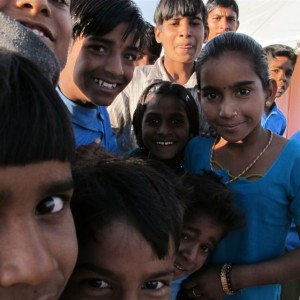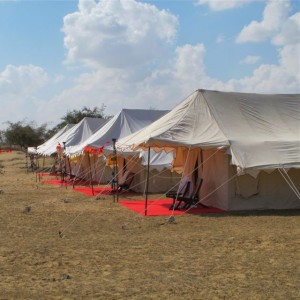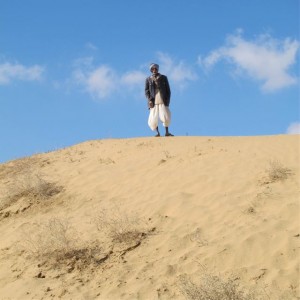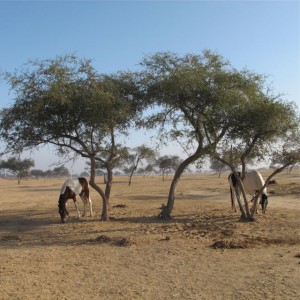 When the camel cart came lurching around a bend and headed straight for us—wooden wheels clattering, turbaned drivers blaring Rajasthani music from a boombox—I was determined to keep my cool. My horse had other ideas: She reared up, spilling me out of my stirrups and into the dirt.
When the camel cart came lurching around a bend and headed straight for us—wooden wheels clattering, turbaned drivers blaring Rajasthani music from a boombox—I was determined to keep my cool. My horse had other ideas: She reared up, spilling me out of my stirrups and into the dirt.
It was an inauspicious start to what I’d hoped would be a transcendent journey: a 10-day group horseback expedition through the vast Thar Desert of northwestern India. The trek, organized by a Massachusetts-based voluntourism organization, Relief Riders International, would bring me and eight others across nearly 100 miles of sandy terrain. Along the way, we would enjoy spectacular scenery—immense dunes, tiny hamlets, lonely temples topped with fluttering flags—and do good too, by undertaking humanitarian projects in remote villages.
Though I’d been on a horse just a few times in my life, I loved the idea of visiting India’s wide-open, windblown spaces, far from its congested cities and the paths of other travelers. The vision of literally riding to the rescue also appealed to my inner drama queen.
But once my horse, a painted Marwari mare named Lakshmi, had tossed me within the first hour, it became clear I’d have to set my sights a bit lower. I was going to have my work cut out for me just staying in the saddle.
Our itinerary promised to be fairly strenuous. Starting in north Rajasthan’s earthen-walled town of Bikaner, we would head south through four camp sites, each about 25 miles from the next. Some days, we would spend several hours riding between locations; others, we would perform community service in nearby villages.
We set out the morning after my fall, following a dirt track marked by tractor treads and camel prints. Around us were sweeping, scrubby plains that reminded me of Wyoming, with knobby khejri trees and the occasional bright-green swath of an irrigated wheat field. After a half hour or so, our group naturally separated, with the more seasoned riders moving ahead at a rollicking canter. Plodding behind with two other less-experienced comrades, I watched wistfully as they thundered away.
The leisurely pace turned out to be a good thing. As well as settling my nerves and allowing me to fall into a rough rhythm with Lakshmi, it let me get to know my fellow riders: Carol, an artist and jeweler from Massachusetts, and Kristie, a Seattle-based photographer and empowerment coach. Our perpetually cheerful riding guide, Ranveer Singh, pointed out the plentiful wildlife of the Thar: petite chinkara antelopes, a laggar falcon scoping prey, silvery desert foxes slinking through the prairie grass.
The downside of riding slow was that we didn’t arrive at our first camp, just outside the village of Deshnok, until after sunset. By the time we slid off our horses, exhausted, it was almost too dark to see the row of elegant canvas tents that had been set up for us. Inside, our beds were made up with sheets and fluffy duvets; there were even bathroom enclosures with cold running water and—miracle of miracles—flushing toilets.
I had only a moment to marvel before a steward arrived with a bucket of hot water for bathing. A few dousings left me clean enough to be presentable at the dining tent, where our group tucked into a spread of curried goat, spiced vegetables, dal and chapati. Afterward I staggered off to bed, where the cacophony of nearby sounds—chuffing horses, bleating goats, meowing peacocks—made me feel like I was falling asleep in a zoo.
The following morning, after getting a daytime look at our camp (where staffers were busy tending to our horses, cooking elaborate meals with just a couple of gas burners and keeping our water running by hand-filling a truck-mounted water tank), we prepared for our first day of community service at two village schools. Striding among us as we gathered up pencil boxes, notebooks, vitamins and soccer balls to donate was Alexander Souri, who founded Relief Riders International in 2004 and leads all of the trips. When a few of us worried that showing up at threadbare local schools to bestow gifts seemed a cursory sort of outreach, he reminded us of the other services his organization provides for schoolkids—like administering deworming medicine to some 2,400 rural Rajasthani children each year, and running youth health-education and employment-training programs in Jaipur’s slum areas.
There was, Mr. Souri said, also value to introducing local children to cultures outside their own. This was borne out during our first school visits, where kids in tidy uniforms mobbed us to try out their halting English and ask countless questions about our lives back home: How do people in your country take care of their elderly? How do they decide who to marry? What sort of food do they eat?
In the afternoons after school visits, staffers would drive truckloads of goats—prized for their milk—into village squares, where we would distribute them to needy residents. The giveaways were mostly joyful occasions, with village officials reading out recipients’ names, and observers laughing and clapping. Occasionally, a widow’s name would be announced and a hush would fall over the crowd. In these rural areas, women who had lost their husbands were considered bad luck, and were shunned; they entered the squares alone, with their faces covered, and retreated quickly once they had claimed their goats. No one cheered for them; no one watched them leave.
Our days took on a cadence: ride, then programs; saddles, then schools and goats. As we threaded south through the villages of Mukham and Kakku, the landscape grew more desertlike. Rugged plains and farms eventually swelled to towering sand dunes. The settlements we encountered also became shabbier and poorer, with cement homes replaced by huts of cow dung and thatch.
 No matter how humble these communities were, they treated us like visiting celebrities. The hoofbeats of our horses would bring families running to the roadside to watch us pass; women in dirt yards doing chores among their livestock (goats, cows, sometimes a kneeling camel or buffalo) would wave and lift their face veils as we went by. Crowds of children, some shoeless, ran after us shouting a phrase left over from colonial days: “Ta ta!”
No matter how humble these communities were, they treated us like visiting celebrities. The hoofbeats of our horses would bring families running to the roadside to watch us pass; women in dirt yards doing chores among their livestock (goats, cows, sometimes a kneeling camel or buffalo) would wave and lift their face veils as we went by. Crowds of children, some shoeless, ran after us shouting a phrase left over from colonial days: “Ta ta!”
I continued to struggle periodically with Lakshmi, feeling in sync with her on some days, frustrated by her skittishness (or, rather, my own inability to manage it) on others. Mr. Singh had coaxed those of us in the slow group to do more trotting, but I was discouraged by the thought that I might finish the trip without once opening up into a cinematic canter. Toward the end of our third riding day, after Lakshmi had spooked at one too many roadside cows, I dismounted in a huff and walked the last hour to camp.
Our group’s humanitarian pièce de résistance was the all-day eye and dental camp that we held at a community center in the village of Kakku. For weeks, Relief Rider staffers had been advertising the camp, which would offer free eye and dental exams, as well as tooth extractions, antibiotics, prescription glasses and even free cataract-removal surgery at a nearby hospital. Since most of the region’s residents had gone their whole lives without seeing a doctor, the registration desk was overrun within an hour.
The treatments were provided by hired ophthalmologists and dentists who had driven in from Jaipur, almost four hours away. Overseeing them was Dr. Mahesh Arora, a 25-year veteran of the Indian Red Cross Society and Relief Riders International’s medical director. My fellow riders and I handled intake forms, ferried supplies to the doctors and filled prescriptions. It was hard work, but by the time we closed up shop, our tallies showed that we had screened and treated 585 patients.
On the morning of our last ride, the mood was bittersweet as we set out from our camp site in Bhundel. I was proud of our contributions: livestock for needy villagers, medical care for hundreds of locals and school supplies for 1,300 children. And we were all excited for that night’s lodging—a hotel in the 16th-century Khimsar Fort, where we’d get our first hot showers in 10 days. But I also felt suffused with melancholy. The amber-colored dunes folding and cresting around us seemed suddenly, exceptionally beautiful; beneath me, Lakshmi strode evenly and—at last—peacefully.
Mr. Singh turned his horse. “Ladies,” he said. “There isn’t much time left. Shall we canter?”
There was no need to answer. Before I knew it, my knees were pressing hard into Lakshmi’s flanks, and we had broken into a furious, glorious run.
The Lowdown: ‘Voluntourism’ Ride in Rajasthan, India
Riding There: Relief Riders International runs several two-week humanitarian/horseback-riding trips in Rajasthan each year, from November through March ($7,450 per person for the Bikaner ride, all-inclusive except for airfare and gratuities, reliefridersinternational.com ).
Getting There: The prelude to each Relief Ride itinerary is an overnight train trip from New Delhi to the ride’s starting point (Bikaner, Jodhpur or Nagaur). Expect a rough, rattly journey in a shared sleeper car, with no running water or flush toilet—a full-immersion introduction to traveling in India.
Where to Stay: Riders stay in tented camps most nights; you might want to spend an extra day or two unwinding afterward. The sleek, modern Trident Gurgaon has a lovely spa and is close to New Delhi’s international airport (from $346 a night, tridenthotels.com ). In Jaipur, the 32 acres of gardens, pools and fountains at the Oberoi Rajvilas can make you forget you’re in the desert (from $565 a night, oberoihotels.com ).
What to Pack: Though the sun in the Thar Desert is fierce even in February (when temperatures are in the low- to mid-80s), at night the temperature plunges, so pack a fleece or light down jacket. Also, for those seven-hour stretches in the saddle, a sheepskin or foam saddle cushion is crucial.


